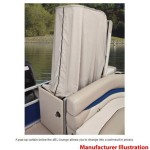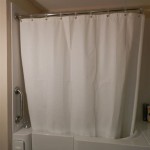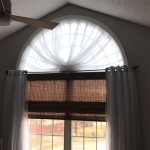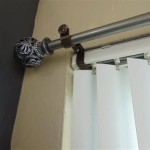Mounting Curtain Poles on Window Frames: A Comprehensive Guide
The placement of curtain poles is a crucial aspect of window treatment design, influencing both the aesthetic appeal and functionality of curtains. While often mounted above the window frame on the wall, attaching the pole directly to the window frame offers an alternative approach, particularly in specific circumstances. This method presents distinct advantages and disadvantages, requiring careful consideration of factors such as window frame material, weight limitations, and desired aesthetic outcome.
The decision to mount a curtain pole on the window frame necessitates a thorough understanding of its implications. This article provides a detailed analysis of the key considerations involved, focusing on the practical aspects of the installation process, the potential benefits, and the inherent limitations.
Evaluating the Suitability of Window Frames for Curtain Pole Mounting
Before proceeding with any installation, a comprehensive assessment of the window frame's suitability is paramount. The primary concern revolves around the material composition and structural integrity of the frame. Certain materials are inherently more conducive to supporting the weight and stress associated with curtains and their hardware.
Wood Frames: Solid wood frames are generally the most suitable option for window frame mounting. The density and stability of wood provide a secure anchor point for screws and brackets. However, the specific type of wood used can affect its load-bearing capacity. Softwoods, such as pine, may require additional reinforcement or the use of specialized screws to prevent stripping or splitting. Hardwoods, such as oak or maple, offer superior strength and are less prone to damage during installation.
Vinyl Frames: Vinyl frames present a more challenging scenario. While vinyl is durable and resistant to moisture, it often lacks the structural integrity required to support significant weight. Direct screw installation into vinyl can result in cracking, warping, or even complete failure of the frame. If vinyl frame mounting is unavoidable, employing specialized self-tapping screws designed for plastic, combined with reinforcing the area with an internal support structure, is recommended. This reinforcement could involve inserting a piece of wood or metal within the vinyl frame cavity to provide a more substantial anchor point.
Aluminum Frames: Aluminum frames share similar limitations to vinyl frames. While aluminum is strong for its weight, the thin gauge typically used in window frames is insufficient for directly supporting curtain poles. Furthermore, drilling into aluminum can weaken the frame and create opportunities for corrosion. Similar to vinyl frames, reinforcing the frame with an internal support structure and using appropriate self-tapping screws is crucial for a successful installation.
The weight of the curtains themselves is a critical factor. Lightweight sheer curtains place minimal stress on the frame, making mounting easier. However, heavier drapes or blackout curtains exert considerably more force, necessitating a more robust mounting system. Assessing the combined weight of the curtains, pole, and hardware is essential in determining the appropriate mounting solution.
Furthermore, the width of the window frame should be considered. Narrow frames offer less surface area for securing brackets, potentially compromising stability. Wider frames provide more options for bracket placement and distribution of weight.
In cases where the window frame is deemed unsuitable for direct mounting, alternative solutions, such as mounting above the frame onto the wall or ceiling, should be explored. These options provide a more secure and stable platform for supporting the curtain pole and curtains.
Installation Techniques and Hardware Considerations
The installation process for mounting curtain poles on window frames differs significantly from standard wall mounting. Precise measurements, careful drilling, and the selection of appropriate hardware are critical for achieving a secure and aesthetically pleasing outcome.
Measurement and Marking: Accurate measurements are paramount to ensure the curtain pole is level and centered. The desired placement of the pole should be carefully marked on the window frame, taking into account the overall aesthetic and the functionality of the curtains. The marks should indicate the exact position of the brackets, ensuring even spacing and alignment.
Pilot Holes: Drilling pilot holes is an essential step to prevent splitting or cracking of the window frame. The size of the pilot hole should be slightly smaller than the diameter of the screws being used. The use of a drill bit specifically designed for the frame material is recommended. For example, a brad point drill bit is ideal for wood frames, while a metal drill bit is more appropriate for aluminum frames. When drilling into vinyl frames, using a slow speed and applying gentle pressure can minimize the risk of cracking.
Screw Selection: The type of screw used is crucial for a secure and long-lasting installation. For wood frames, wood screws with a coarse thread provide excellent grip and holding power. The length of the screw should be sufficient to penetrate deeply into the frame without protruding through the other side. For vinyl and aluminum frames, self-tapping screws designed for plastic or metal are necessary. These screws have a specialized tip that allows them to create their own threads as they are driven into the material. The use of washers beneath the screw heads can help distribute the load and prevent the screws from pulling through the frame.
Bracket Selection: The choice of brackets depends on the size of the curtain pole, the weight of the curtains, and the style of the window frame. Smaller, more discreet brackets are suitable for lightweight curtains and narrow frames. Larger, more robust brackets are necessary for heavier curtains and wider frames. The brackets should be made of a durable material, such as steel or aluminum, and should be compatible with the diameter of the curtain pole. Adjustable brackets can be useful for achieving precise alignment and leveling of the pole.
Reinforcement Techniques: In cases where the window frame is weak or prone to damage, reinforcement techniques can be employed to enhance the stability of the installation. As previously mentioned, inserting a piece of wood or metal within the frame cavity can provide a more substantial anchor point for the screws. Another option is to use metal backing plates behind the brackets to distribute the load over a larger area. These backing plates can be custom-made to fit the specific shape and size of the window frame.
After installation, it is essential to thoroughly inspect the mounting to ensure it is secure and stable. Any signs of looseness or instability should be addressed immediately to prevent the curtains from falling and potentially causing damage.
Advantages and Disadvantages of Window Frame Mounting
Mounting curtain poles directly to the window frame presents both advantages and disadvantages compared to traditional wall mounting. Understanding these factors is crucial for making an informed decision about the most suitable approach for a given situation.
Space Saving: One of the primary advantages of window frame mounting is its space-saving potential. In rooms with limited wall space, such as small bedrooms or kitchens, mounting the pole directly to the frame can free up valuable wall space for other uses. This is particularly beneficial in situations where there is limited space above the window.
Aesthetic Considerations: Window frame mounting can create a clean and integrated look, particularly when the curtains are closely fitted to the window. This can be especially desirable in modern or minimalist interiors where a streamlined aesthetic is prioritized. The curtains appear to be an integral part of the window rather than a separate element attached to the wall.
Light Control: Mounting the curtain pole directly to the window frame can improve light control by minimizing gaps between the curtains and the window. This is particularly beneficial for blackout curtains, where the goal is to block out as much light as possible. The close fit of the curtains prevents light from leaking around the edges, creating a darker and more comfortable environment.
Ease of Installation: In some cases, window frame mounting can be easier than wall mounting, particularly if the wall is made of a difficult-to-drill material, such as concrete or brick. Drilling into wood or vinyl frames is generally simpler and requires less specialized tools.
However, there are also significant disadvantages to consider.
Weight Limitations: As previously discussed, window frames often have limited weight-bearing capacity. This can restrict the choice of curtains to lightweight materials, such as sheer fabrics. Heavier drapes or blackout curtains may be too heavy for the frame to support safely. Exceeding the weight limit can lead to damage or failure of the frame.
Potential for Damage: Drilling into window frames can damage the frame itself, particularly if done incorrectly or with inappropriate tools. Cracking, splitting, or warping of the frame can compromise its structural integrity and reduce its weather resistance. Repairs to damaged window frames can be costly and time-consuming.
Limited Adjustability: Window frame mounting offers less flexibility in terms of adjusting the position of the curtain pole. Once the brackets are installed, it can be difficult to move or reposition the pole without creating new holes in the frame. This can be a disadvantage if the initial placement is not ideal or if the desired aesthetic changes over time.
Warranty Issues: Drilling into window frames may void the manufacturer's warranty. Many window manufacturers explicitly state that any modifications to the frame will invalidate the warranty. This is an important consideration, particularly if the windows are relatively new.
Ultimately, the decision to mount curtain poles on window frames requires a careful balancing of these advantages and disadvantages. A thorough assessment of the window frame's suitability, the weight of the curtains, and the desired aesthetic outcome is essential for making an informed choice.

Types Of Curtain Rods The Home

Screwed Curtain Brackets Into Window Trim Hometalk

Adjustable Curtain Tension Rod 30 52 Inside Window Frames 3 4 D

Hanging Curtain Rods On Window Frame Homevshouse

Jim Lawrence Create Your Made To Measure Curtain Pole

How To Install Curtain Rods Best Practices The Shade

How To Choose A Curtain Rod For Your Window Decor 10 Steps

Follure Single Hang Curtain Rod Holders Bracket Into Window Frame

5 Easy Ways To Hang Curtains Without Drilling

8pcs No Drill Curtain Rod Holder Pole Brackets Into Wooden Window Frame








